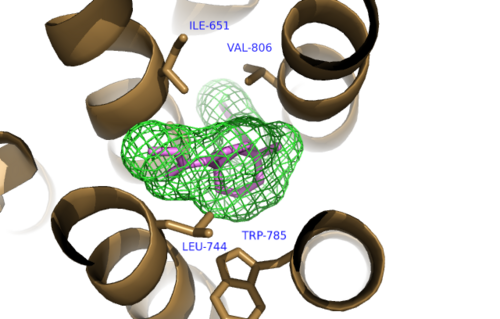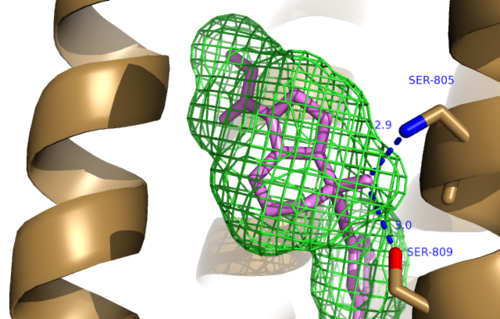User:Daniel Schemenauer/Sandbox 1
From Proteopedia
(Difference between revisions)
| Line 9: | Line 9: | ||
===Key Interactions=== | ===Key Interactions=== | ||
A number of intramolecular interactions within the trans-membrane domain stabilize the inactive conformation of mGlu<sub>5</sub>. The first of these interactions is an ionic interaction, termed the <scene name='72/726409/Ionic_lock2/1'>Ionic Lock</scene>, between Lysine 665 of TM3 and Glutamate 770 of TM6. Evidence for the importance of this interaction came through a kinetic study of mutant proteins where both residues were separately mutated to alanine, resulting in constitutive activity of the GPCR and its coupled pathway<ref name="Primary">PMID: 25042998 </ref>. A second critical interaction that stabilizes the inactive conformer is a <scene name='72/726409/Hydrogen_bond_614-668/1'>Hydrogen Bond </scene> between Serine 614 of ICL1 and Arginine 668 of TM3. Similarly, when Serine 614 was mutated to alanine, high levels of activity were seen in the mutant GPCR<ref name="Primary">PMID: 25042998 </ref>. | A number of intramolecular interactions within the trans-membrane domain stabilize the inactive conformation of mGlu<sub>5</sub>. The first of these interactions is an ionic interaction, termed the <scene name='72/726409/Ionic_lock2/1'>Ionic Lock</scene>, between Lysine 665 of TM3 and Glutamate 770 of TM6. Evidence for the importance of this interaction came through a kinetic study of mutant proteins where both residues were separately mutated to alanine, resulting in constitutive activity of the GPCR and its coupled pathway<ref name="Primary">PMID: 25042998 </ref>. A second critical interaction that stabilizes the inactive conformer is a <scene name='72/726409/Hydrogen_bond_614-668/1'>Hydrogen Bond </scene> between Serine 614 of ICL1 and Arginine 668 of TM3. Similarly, when Serine 614 was mutated to alanine, high levels of activity were seen in the mutant GPCR<ref name="Primary">PMID: 25042998 </ref>. | ||
| - | A <scene name='72/726404/Scene_6/ | + | A <scene name='72/726404/Scene_6/6'>Disulfide Bond </scene> between Cysteine 644 of TM3 and Cysteine 733 of ECL2 is critical at anchoring ECL2 and is highly conserved across Class C GPCR’s<ref name="Primary">PMID: 25042998 </ref>. The ECL2 position combined with the helical bundle of the trans-membrane domain creates a <scene name='72/726409/Electrogradient2/3'>Binding Cap</scene> that restricts entrance to the allosteric binding site within the seven trans-membrane α-helices. This restricted entrance has no effect on the natural ligand, glutamate, as it binds to the extracellular domain, but this entrance dictates potential drug targets that act through allosteric modulation<ref name="Primary">PMID: 25042998 </ref>. |
===Comparison with Class A and B GPCRs=== | ===Comparison with Class A and B GPCRs=== | ||
The structure of the trans-membrane domain of mGlu<sub>5</sub> was compared to rhodopsin, a class A GPCR, and CRF<sub>1</sub>R, a class B GPCR. The superimposition of all three structures demonstrated the greatest divergence occurred across the top half of the trans-membrane bundle, attributing to the different extracellular domains that accompany each GPCR class. Furthermore, mGlu<sub>5</sub> TM7 is shifted inwards 5 Å compared to the class A GPCR, and TM5 is shifted inwards 6 Å compared to both GPCRs, thus narrowing the allosteric binding entrance<ref name="Primary">PMID: 25042998 </ref>. | The structure of the trans-membrane domain of mGlu<sub>5</sub> was compared to rhodopsin, a class A GPCR, and CRF<sub>1</sub>R, a class B GPCR. The superimposition of all three structures demonstrated the greatest divergence occurred across the top half of the trans-membrane bundle, attributing to the different extracellular domains that accompany each GPCR class. Furthermore, mGlu<sub>5</sub> TM7 is shifted inwards 5 Å compared to the class A GPCR, and TM5 is shifted inwards 6 Å compared to both GPCRs, thus narrowing the allosteric binding entrance<ref name="Primary">PMID: 25042998 </ref>. | ||
Revision as of 12:31, 12 April 2016
| |||||||||||
References
- ↑ Vassilatis DK, Hohmann JG, Zeng H, Li F, Ranchalis JE, Mortrud MT, Brown A, Rodriguez SS, Weller JR, Wright AC, Bergmann JE, Gaitanaris GA. The G protein-coupled receptor repertoires of human and mouse. Proc Natl Acad Sci U S A. 2003 Apr 15;100(8):4903-8. Epub 2003 Apr 4. PMID:12679517 doi:http://dx.doi.org/10.1073/pnas.0230374100
- ↑ 2.0 2.1 Venkatakrishnan AJ, Deupi X, Lebon G, Tate CG, Schertler GF, Babu MM. Molecular signatures of G-protein-coupled receptors. Nature. 2013 Feb 14;494(7436):185-94. doi: 10.1038/nature11896. PMID:23407534 doi:http://dx.doi.org/10.1038/nature11896
- ↑ Pin JP, Galvez T, Prezeau L. Evolution, structure, and activation mechanism of family 3/C G-protein-coupled receptors. Pharmacol Ther. 2003 Jun;98(3):325-54. PMID:12782243
- ↑ 4.0 4.1 4.2 4.3 4.4 4.5 4.6 4.7 4.8 4.9 Dore AS, Okrasa K, Patel JC, Serrano-Vega M, Bennett K, Cooke RM, Errey JC, Jazayeri A, Khan S, Tehan B, Weir M, Wiggin GR, Marshall FH. Structure of class C GPCR metabotropic glutamate receptor 5 transmembrane domain. Nature. 2014 Jul 31;511(7511):557-62. doi: 10.1038/nature13396. Epub 2014 Jul 6. PMID:25042998 doi:http://dx.doi.org/10.1038/nature13396
- ↑ Shigemoto R, Nomura S, Ohishi H, Sugihara H, Nakanishi S, Mizuno N. Immunohistochemical localization of a metabotropic glutamate receptor, mGluR5, in the rat brain. Neurosci Lett. 1993 Nov 26;163(1):53-7. PMID:8295733
- ↑ Li G, Jorgensen M, Campbell BM. Metabotropic glutamate receptor 5-negative allosteric modulators for the treatment of psychiatric and neurological disorders (2009-July 2013). Pharm Pat Anal. 2013 Nov;2(6):767-802. doi: 10.4155/ppa.13.58. PMID:24237242 doi:http://dx.doi.org/10.4155/ppa.13.58


